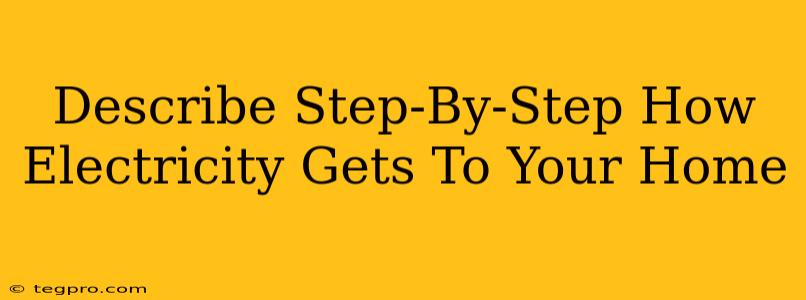Getting electricity to your home is a complex process involving many steps and a vast network of infrastructure. Let's break down this journey, from the power plant to your wall socket.
1. Generation: Where It All Begins
The process starts at a power plant, where electricity is generated. There are several ways this happens:
- Fossil Fuel Plants: These plants burn coal, natural gas, or oil to heat water, creating steam that spins turbines connected to generators. This is a common, but environmentally impactful, method.
- Nuclear Power Plants: Nuclear fission generates heat, similarly powering turbines and generators. This method produces little to no greenhouse gas emissions, but involves managing nuclear waste.
- Hydroelectric Plants: The power of moving water spins turbines, generating electricity. This is a renewable resource, but dam construction can impact ecosystems.
- Solar Power Plants: Photovoltaic cells convert sunlight directly into electricity. This is a clean and renewable energy source, but relies on sunlight availability.
- Wind Power Plants: Wind turbines capture kinetic energy from wind, converting it into electricity. This is another clean and renewable energy source.
Regardless of the source, the generated electricity is alternating current (AC) and needs to be managed and distributed.
2. Transmission: High-Voltage Highways
The electricity produced at the power plant is stepped up to extremely high voltages (typically 115,000 to 765,000 volts) using transformers. This high voltage is crucial for efficient transmission over long distances. Thick, high-capacity wires carry this electricity along transmission lines, often across vast distances, forming a large-scale power grid. These transmission lines are typically made of steel-reinforced aluminum or copper conductors to minimize energy losses during transmission.
Minimizing Energy Loss during Transmission
Transmission lines employ high voltages to reduce energy loss. Higher voltage means lower current for the same power, minimizing energy loss due to resistance in the wires (I²R losses). This is a critical aspect of efficient power delivery.
3. Subtransmission: Breaking Down the Voltage
Once the electricity reaches a substation near your area, the voltage is stepped down to a lower level, typically 138,000 or 69,000 volts. This subtransmission network distributes the power to local areas.
4. Distribution: Local Networks
The electricity then moves to distribution substations, where the voltage is further reduced, typically to 12,000-34,500 volts. From these substations, the electricity travels along distribution lines, often strung along utility poles, to your neighborhood.
5. Transformation: Reaching Your Home
Finally, the electricity reaches a transformer located near your home (often mounted on a pole). This transformer steps down the voltage to the standard 240 volts (or 120 volts for individual circuits) used in your home. This lower voltage is safe for household appliances and electronics.
6. Your Home: The Final Destination
The electricity now flows into your home through a service cable connected to your meter. Your electrical panel then distributes the electricity throughout your home, powering lights, appliances, and electronics. Circuit breakers protect against overloads and short circuits.
Understanding the Complex System
The journey of electricity to your home is a testament to sophisticated engineering and infrastructure. From generation to consumption, the process involves multiple stages of voltage transformation and transmission to ensure efficient and safe delivery of power. Each step plays a vital role in powering your home and ensuring a reliable electricity supply. Understanding this process allows for a greater appreciation of the complex systems that support our modern lifestyle.

